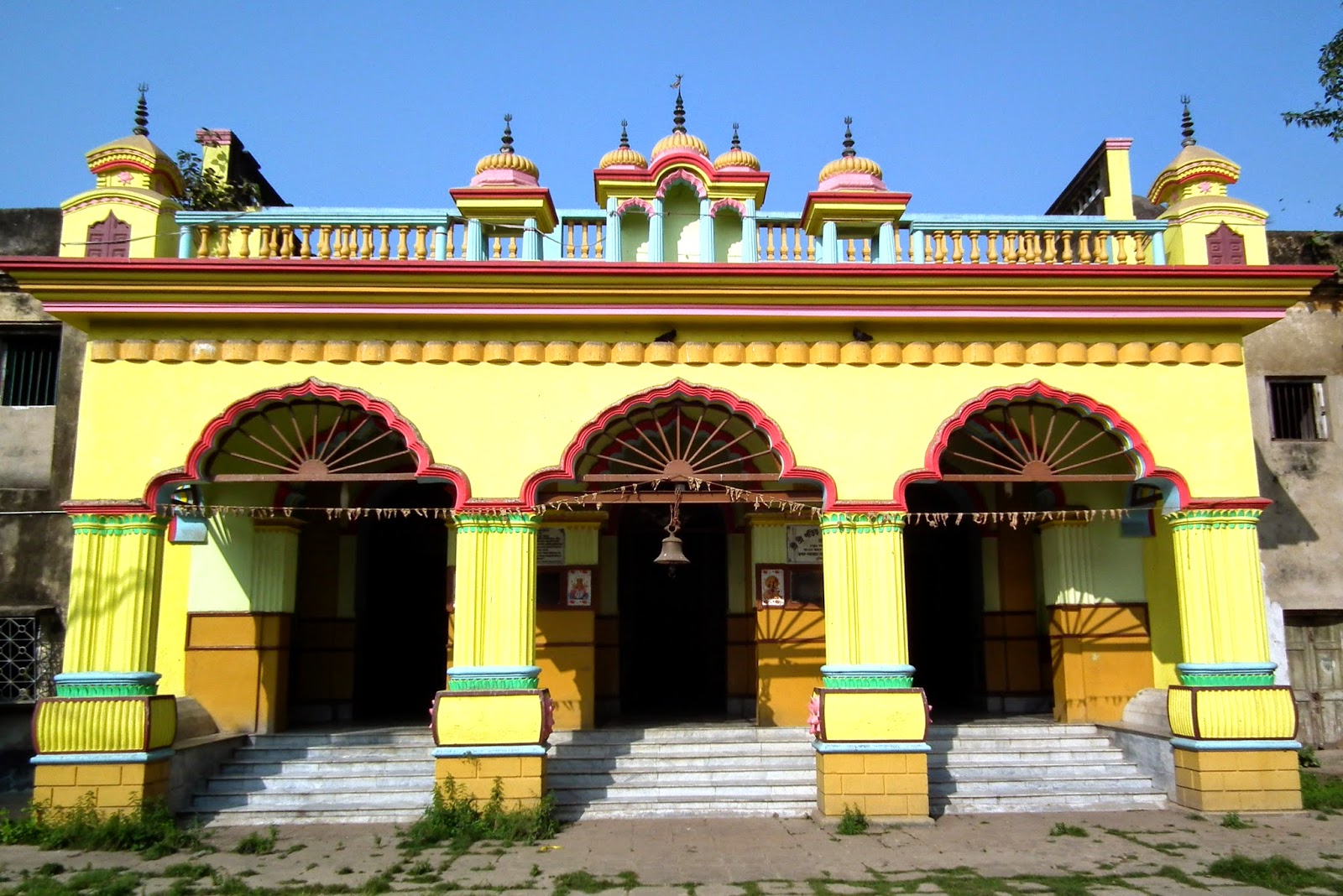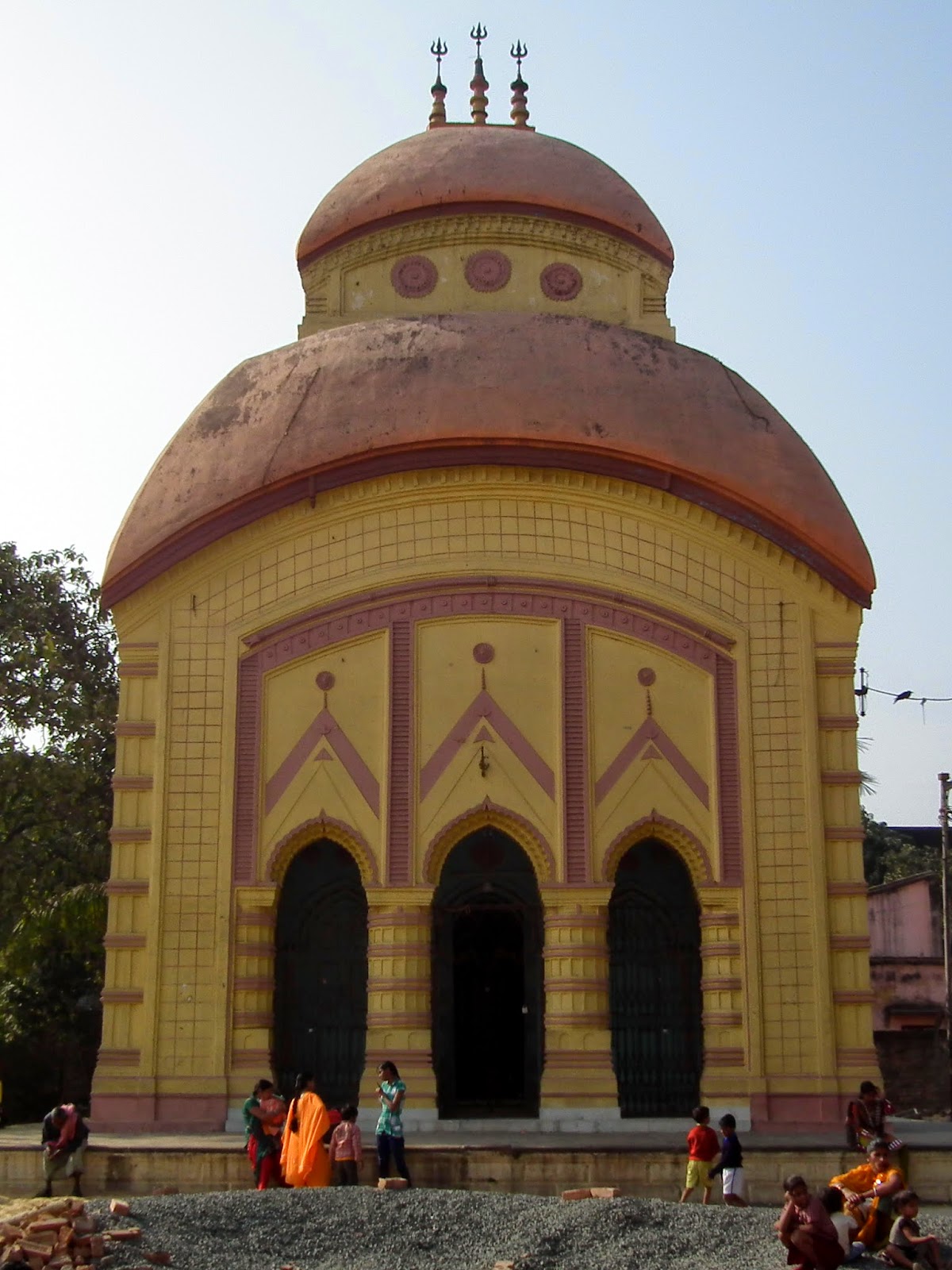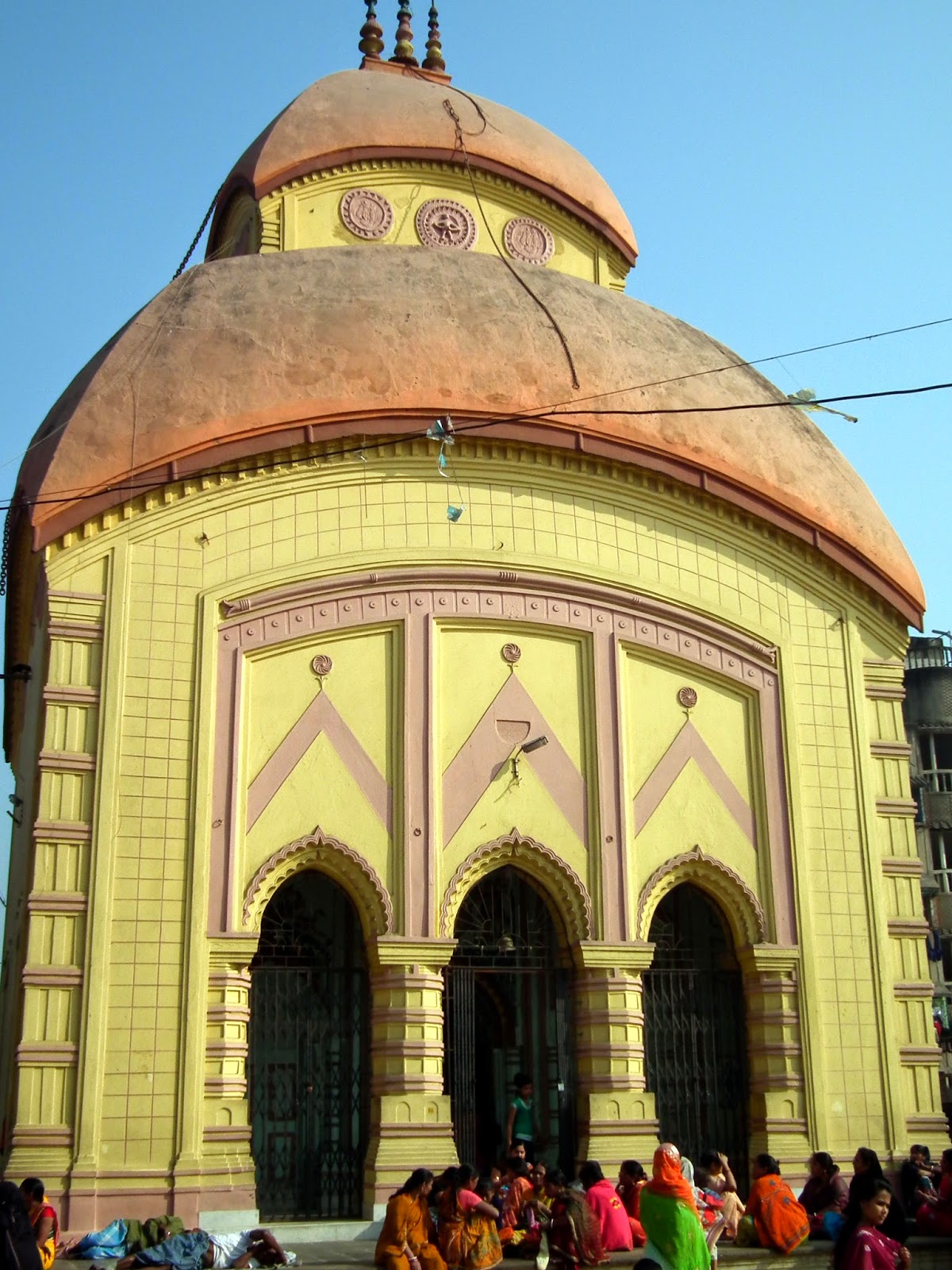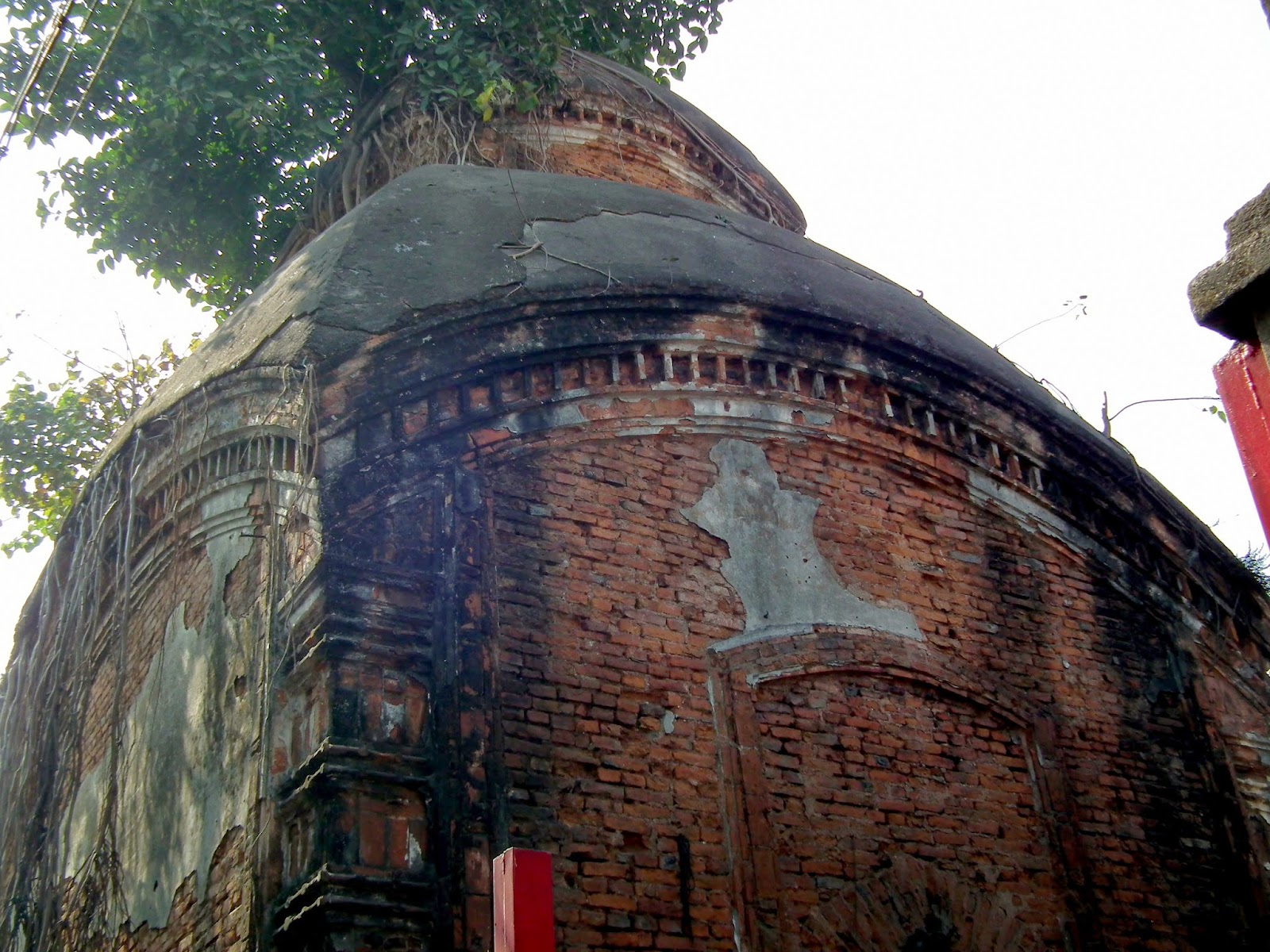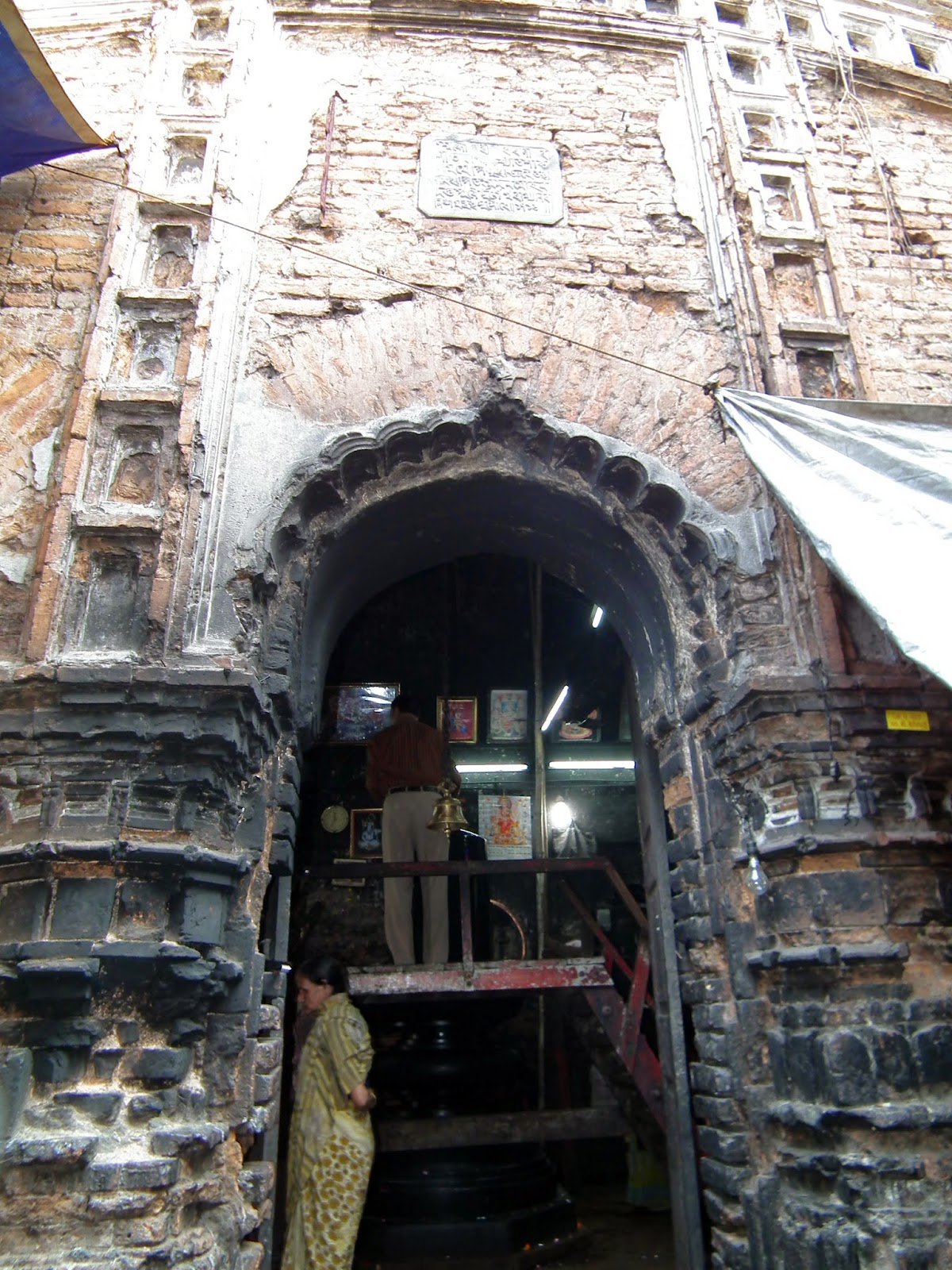Black Pagoda temple at Kumartuli
One of the
oldest Viz. the famous nine-jewelled pagoda build in 1730 by the Black Zamidar,
Govindaram Mitra and engraved by the Daniells does not exist in its original
form, its memory is enshrined by a smaller temple which stands on its site of
the original shrine.
Rameswara
Siva Temple
Builders of
most of the 18th Century big eight-roofed ( atchala) temples were
very rich. One such specimen of undistorted form of traditional atchala temple
stands at 51, Nandaram Sen street, Shovabazar. The temple carries five stone
plaques. Two atone tablets at the entrance of the temple carry the inscription
which reads “ Bengali San 1061 date 30 chaitra” i.e.1655 A.D. Sri Purna Chandra
Dey mentions that this date is erratic. It has been estimated from the
architectural point of view that the temple had been build sometimes around mid
18th century. “Rameswara Siva Temple” was founded by Nandaram Sen,
who acted as assistant to Raalph Sheldon ; Receiver of Revenues in the early
decades of the 18th century, still stands on the street bearing the
name of its founder.
The Chitteswari Temple
The Chitteswari Temple
according to one account was founded by Monohar alies Mahabir Ghosh, an
employee of Raja Todarmal in 1610, according to another a robber chieftain
named Chitto(Chitu Dakat). An old print of Charles O’Doyly (1835) gives a
glimpse of the Chitteswari Temple build in style of a Navaratna.
The twin Temple of Bhukailash Rajbari
These twin
heritage temples were built by Zamidar Joynarayan Ghosal more than 200 years
ago in Kidderpore’s Bhukailash Rajbari Estate in 1781. The 18-foot-tall Shivalinga
installed in the temple has been carved out of a single kashti stone and is
believed to be the tallest( I personally think Durgasher Shib at Ramjan lane is
the tallest one) Shivalinga of its kind in Asia. The Temples come up soon after
Joynarayan Ghosal shifted his estate from Fort William to Khidderpore. The Bhukailash
Rajbari here used to sprawl over 150 Bighas. The temples Krishna-chendreshwar
and Rakta-kamaleshwar were dedicated by Joynarayan Ghosal to the name of his
father and mother. Besides the twin Shiva temples, the estate also houses an
ancient Kulodevi Patitpabani Durga temple which was built in 1782. This Durga
idol here is made of Astadhatu ( eight metals).
A
Group of Temples in Tollygunge
Another old
temple in the city, lying south of Kalighat dedicated to shyam Chand was
erected in 1843 by Udayarayan Mondal of Bawali. Adjacent to it may be seen a clauster
of 12 smaller Shiva temples. In the
vicinity of the same site there is a whole complex of Navaratna Temple of
Gopal, 2 Pancharatna and 10 atchala temples of shiva. These temples “NAVARATNA”
style is common in Bengal school of architecture.
It is not easy to find a place in Bengal where
38 different temples, all aged more than 150 years, are co-existing in a small
complex. “Bouwali” a place hardly
two hours from Kolkata is where this
treasure exists.
The “MONDAL”
famously, who got this place as a gift from raja Man Singh, a hamlet, who ruled
Bouwali, in the 15th century. The Mandals where originally from a
place named “Shyamganj”. Later they acquired a huge property in Tollygunge.
Basudev Mondal
was the founder of this royal family. The family was later connected to Rani
Rashmoni’s family by marriage. The two best specimens of Ratna –type of temples
are the Radhanath Temple of Tollygunge in the south and the better-known temple
of Dakshineswar in the north.
.
Pancharatna
temple at kenderdine lane
This shiva
temple at Kenderdine lane, made of old fashioned bricks and founded by
Trilokram Pakrashi, Dewan of the Forty Willium, are also among the Oldest
religious relics of Kolkata.
Not much is
known about the structural details of these four ruined, delapidated temples. Stated
to have been built by Baburam Ghosh in early 19th Century. There are
five temples, build in typical ATCHALA style of the Bengal school, of which
three are crumbling. Stucco work, with three terracotta panels at the entrances
of the temple. Several smaller terracotta on the upper walls of the temple. The
terracotta sculptures are very artistic, the well-crafted terracotta panels on
the side wall tell many stories. The social changes are depiction along with
stories from the religious texts.
Durgeswar
Shiv Temple
An example of the deviation from customary style
of Atchala (8 roofed) tri-arched Temple is Durgeswar Shiv Temple at 16, Md.
Ramjan Lane at Nimtala. Stated to have been built by Dutta family of hatkhola (
two sons of Madanmohan Dutta) in the year 1794.
This temple is west facing. Compared to its area coverage, the hight is much out of proportion, keeping with the massive size of the deity(Shivalinga). Length of this atchala Mandir is 23’6”, breadth 28’6” and height about 50 feet. A gigantic Shiva linga is there on the garva-griha which is about 10 feet high.
Baneswar
Shiv Temple
Probably
the best example of terracotta work on temple walls in Kolkata is Baneswar Shiv
Temple built by Banamali Sarkar. Situated at 2/5, Banamali Sarkar Street in
Kumartuli, this south facing temple has a single entrance and eight roofed
(Atchala). Its original entrance
has been
blocked by a wall built later. Thus ruining the lower part of the terracotta
plaques. However, a part of the three rows of terracotta plaques places on the
curved cornice still exists in dilapidated condition.
The wall
above the original entrance carries few slim plaques carrying multiplication
signs placed in a curved horizontal row. At both ends of the curved cornice are
placed a peacock holding snake with its beak. The next row has a row of plaques
in the form of twisted rope. Notwithstanding the massive size of the temple,
its height is proportional to its area coverage.
According to
Devid Mccutchion the Siva Temple at 2/5 Banamali Sarkar Street, Kumartuli is “Perhaps
the oldest temple in Calcutta to have survived more or less in its original form”.
Nearly
all the temples associated with the old Kolkata have disappeared in their
original form and have undergone radical renovation.
Source : 1. H.E.A Cotton " Calcutta Old and New"
2. David Mccutchion " The Temples of Calcutta" Bengal Past & Present (1968)
3. Tarapada Satra "Kolkater Mandir, Masjid"
4 Manju Halder " Banglar Mandir"
5. Amiya Kumar Banerjee " Temples of Caltutta and its Neighbourhood."
6. Kolkater purakatha edited by Debasish Basu , An article written by Tarapada Satra under
" Kolkater Mandir Sthapatya"
Research -Santanu Roy.
Picture Courtesy - Sudip Ghosh.
Source : 1. H.E.A Cotton " Calcutta Old and New"
2. David Mccutchion " The Temples of Calcutta" Bengal Past & Present (1968)
3. Tarapada Satra "Kolkater Mandir, Masjid"
4 Manju Halder " Banglar Mandir"
5. Amiya Kumar Banerjee " Temples of Caltutta and its Neighbourhood."
6. Kolkater purakatha edited by Debasish Basu , An article written by Tarapada Satra under
" Kolkater Mandir Sthapatya"
Research -Santanu Roy.
Picture Courtesy - Sudip Ghosh.







